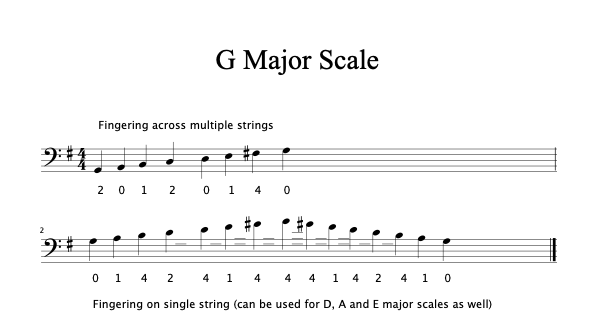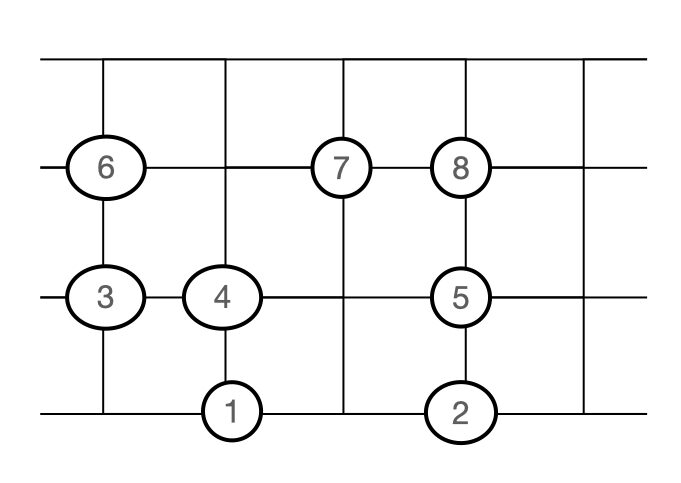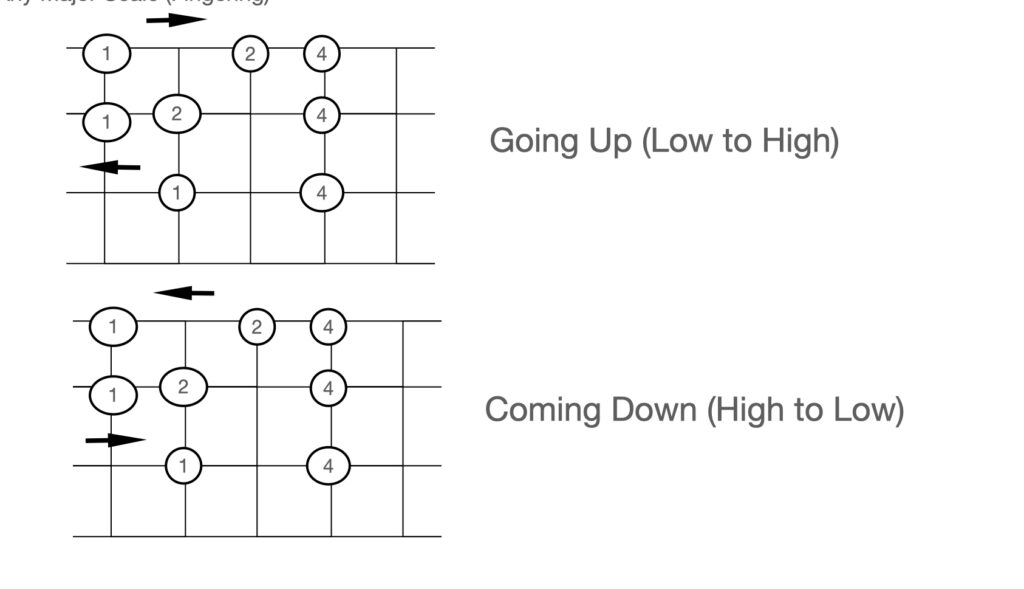For a more detailed explanation of what scales are, see the Music Theory page.
Scales can be played in open or closed positions. Open position scales use the open strings, where available, and therefore the fingering differs from case to scale. Closed position scales use the same fingering pattern for each scale, and therefore, as long as the pattern is learnt for one scale, it can be quickly applied to any other, by changing the starting position, or string.
Fingering Positions
We can describe our hand position on the neck in relation to imaginary frets, or using the classical fingering positions. These are explained in more detail in the Fingering Positions page.
Open Position Scales
An open position scale is one where we use the open strings, and therefore the fingering varies from scale to scale. The following diagram shows the fingering for the G major scale, starting on the G (3rd fret) on the E string, or alternatibvlye, the single string fingering, using just the G string.

Normally we would play this scale across the strings, starting on the 3rd fret on the E string. Note that we star with the second finger on the G. This allows us to play the next nots as Open – First – Second, and then the following notes as Open – First – Fourth – i.e. we dont have to change ourt hand position. It seems intuitive to start on the first finger, but then we would have to needlessly channge hand position.
The single string scale is not normally something that we would play in its entirety, but it is a useful practice tool, both to devcelop our intonartion up and down the string, and also something that we might well use parts of when playing. Note that the fingering is not the same up and down. This is because the approach is to try and make sure that, as much as possible, we can position the next hand shift based on the current position.
If we look at the first four notes (G, A, B and C). The G is open so we have our hand in first position (second fret) ready to play the A and B with 1st and 4th finger respectively. The next note C is a single fret higher. If we shift our hand so that the 1st finger is in the same position as the 4th finger was, then the 2nd finger is in the correct place to play C. The next note is a D (2 frets higher) so if we shift our hand so that the 1st finger is where the 2nd finger was, the D will be under our 4th finger. there is no getting round the fact that we now have to do a full 2 fret shift to play E and F# with 1st and 4th finger srestectivel, but by moving our hand a further fret, so that the 2nd finger is where our 4th finger is, we can then play the final G with our 4th finger.
A similar pattern is used on the return, making sure that, as far as possible, when we shift, one of our fingers is moving to where the previous one was.
Individual players will have variations on the above, but the same principle should apply. For example, with a ‘D scale’ base (where the fret board join is a D), it is easy to go straight to the high D with first finger. With an Eb scale, you might prefer not to do that.
For notated fingerings, for the common major scales, see Major Scale Fingerings (Notation).
Closed position scales
A closed position scale is one where all the notes are fretted – i.e. there are no open strings. The following diagrams show the notes for a major and harmonic minor scale. There are other scales and modes available, but this page concentrates on these two forms.
The closed position scale uses three strings, and can therefore start on either the E or A string. Note that the 1st and forth note of the scale are always on the same fret, as are the 5th and the 8th (the octave). This will be useful information when we look at arpeggios (see ARPEGIO page)

On the Double Bass, we can only cover one tone (i.e. two frets from a single position). This means that, if we play the first note of the scale with our first finger, the second note can be played with the forth finger (as it is 2 frets away). The next note is one fret lower on the next string, so we have to shift our hand backwards to play that note with the first finger. If we then shift forward again, we can play the next two notes (4 and 5) with the first and forth finger. Note that this is exactly the same position that we played the first two notes in. The 6th note is on the same fret as the 3rd, so we have to shift back again. The final two notes require the hand to be shifted forward agin, and then the 7th and 8th can be played with fingers 2 and 4 respectively. This is shown below.

Note in the above that the numbers refer to fingers, not the degree of the scale!
Links to download additional material showing of open scale notes and fingerings, as well as Harmonic Minor scales can be found on the Resources page.